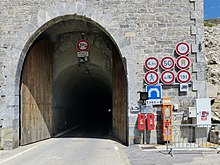
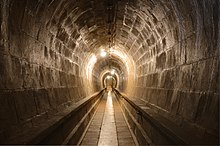
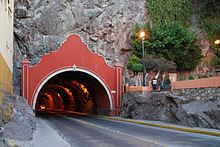
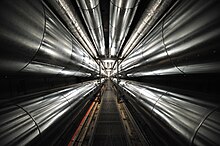
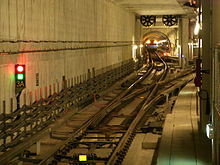

A tunnel is an underground or undersea passageway. It is dug through surrounding soil, earth or rock, or laid under water, and is usually completely enclosed except for the two portals common at each end, though there may be access and ventilation openings at various points along the length. A pipeline differs significantly from a tunnel,[1] though some recent tunnels have used immersed tube construction techniques rather than traditional tunnel boring methods.[2]
A tunnel may be for foot or vehicular road traffic, for rail traffic, or for a canal. The central portions of a rapid transit network are usually in the tunnel. Some tunnels are used as sewers or aqueducts to supply water for consumption or for hydroelectric stations. Utility tunnels are used for routing steam, chilled water, electrical power or telecommunication cables, as well as connecting buildings for convenient passage of people and equipment.[3]
Secret tunnels are built for military purposes, or by civilians for smuggling of weapons, contraband, or people.[4] Special tunnels, such as wildlife crossings, are built to allow wildlife to cross human-made barriers safely.[5] Tunnels can be connected together in tunnel networks.
A tunnel is relatively long and narrow; the length is often much greater than twice the diameter, although similar shorter excavations can be constructed, such as cross passages between tunnels. The definition of what constitutes a tunnel can vary widely from source to source. For example, in the United Kingdom, a road tunnel is defined as "a subsurface highway structure enclosed for a length of 150 metres (490 ft) or more."[6] In the United States, the NFPA definition of a tunnel is "An underground structure with a design length greater than 23 m (75 ft) and a diameter greater than 1,800 millimetres (5.9 ft)."[7]
- ^ Zhou, Man; Su, Xiaolong; Chen, Yaying; An, Lin (2 October 2022). "New Technologies and Challenges in the Construction of the Immersed Tube Tunnel of the Hong Kong-Zhuhai-Macao Link". Structural Engineering International. 32 (4): 455–464. doi:10.1080/10168664.2021.1904487. ISSN 1016-8664.
- ^ Takahashi, Yutaka (2009). Water Storage, Transport, and Distribution. EOLSS Publications. pp. 318–319. ISBN 9781848261761.
- ^ Salazar, Waneta. Tunnels in Civil Engineering. Delhi, India : White Word Publications, 2012.
- ^ Sorrensen, Cynthia (1 July 2014). "Making the Subterranean Visible: Security, Tunnels, and the United States–Mexico Border". Geographical Review. 104 (3): 328–345. doi:10.1111/j.1931-0846.2014.12029.x. ISSN 0016-7428.
- ^ Brodziewska, J. (2005). Wildlife tunnels and fauna bridges in Poland: past, present and future, 1997-2013. UC Davis: Road Ecology Center. Retrieved from https://escholarship.org/uc/item/4wd0j27j
- ^ Highway Structures & Bridges Design CD 352, Design of road tunnels (formerly BD 78/99). The Department for Transport. 2020.
- ^ NFPA Standard for Safeguarding Construction, Alteration, and Demolition Operations. National Fire Protection Association.